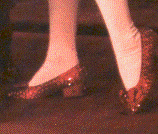
June 21, 1985 - Disney's Return to Oz premieres at Radio City Music Hall. Gary Kurtz is the executive producer of this 109-minute live action filmed in England. The story combines plot elements from The Marvelous Land of Oz and Ozma of Oz, with a lengthy opening segment original to the screenplay. Walter Murch, who also directs, and Gill Dennis write the screenplay.
Its September release fails to appeal to the public. The short-lived tie-in merchandise includes puppets, games, puzzles, books and records. The film is more enthusiastically received - and inspires more merchandise - in Japan. The cast includes 10-year-old Fairuza Balk as Dorothy (the youngest of 400 children who tried out for the part); Nicol Williamson as the Nome King; Sophie Ward as Princess Mombi. Michael Sundin, an acrobat, was Tik Tok in costume that required him to curl up with his head to his knees and walk backwards.
Costume designer Raymond Hughes used John R. Neill's illustrations to guide his work. A coronation sequence included brief glimpses of dozens of Oz characters from the series.
Products connected with the film include a novelization by Joan D. Vinge published by Ballantine/Del Ray Books, New York; five Little Golden Books; Walt Disney Pictures' Return to Oz by Scholastic, New York, which presents the story through cartoon-style color panels and is a offered in American, British and German printings; a "retold by William Furstenberg" version of The Wizard of Oz published by Weekly Reader Books and available only through its book club; boxed jig saw and frame-tray puzzles; Tops Bubble Gum trading cards; plush hand puppets available as a Smucker's promotion; audio and video tapes; activity and coloring books; plastic jointed figures; stuffed dolls; an 18-inch German Dorothy Gale Doll (also marketed in Great Britain) of Fairuza in costume; pins and buttons; film posters; and other items. Dunkin' Donuts also used the film to promote its doughnut holes.
Illustrator Maurice Sendak is initially selected to develop concepts for set designs, but proves unavailable during the production's time frame. He does, however, finish one Oz poster.

[Writer-director Walter Murch coaches Fairuza Balk, the nine-year-old schoolgirl chosen to play Dorothy in Walt
Disney's big-budget production of Return to Oz. Based on the second and third books in L. Frank Baum's perennially
popular series, the film takes Dorothy back to the Land of Oz where she finds the Emerald City in ruins and her friends
turned to stone by the nefarious Nome King.]
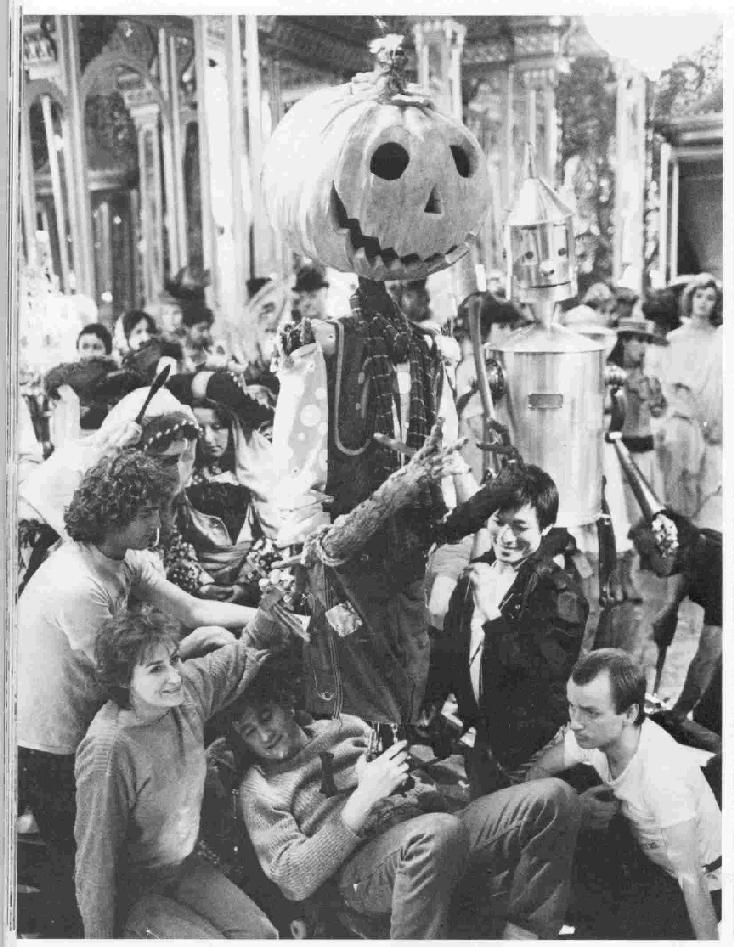
['Trolley Jack' was a fully- mechanized puppet employed for waist-up shots. Mounted on a four-wheeled cart for mobility, 'Trolley Jack' was operated primarily by Brian Henson who controlled the head and body movements with a single rod mechanism which extended down from the base of the puppet. Other puppeteers assisted with facial articulations. In situations where neither puppet would suffice, a third variation of the Jack Pumpkinhead character was devised -with a human operator, Stewart Larange.]

[ Creating a convincing mechanical chicken proved to be one of the more challenging assignments for the film's animatronics staff. One of the early proposals was to produce a larger-than-life bird and photograph it with oversized settings and props-an idea which was ultimately discarded as impractical. In the end, Conway and crew and crew were able to cram the necessary articulating mechanisms into an actual-size chicken figure. Billina's lifelike coat was produced by Val Jones, employing a hand-woven elastic fabric laced with loops of wool to which real chicken feathers were painstakingly glued. Stephen Norrington -at work on one of the mechanical legs - was in charge of the overall Billina construction project. Depending on which version was in use, the operator's hand entered either from the back or the underside of the bird, with two fingers extending up through the neck and into a pair of cups in the back of the skull. Essential neck and head moves were produced with the first two fingers, augmented by minute cable mechanisms for eye and mouth movements. Conway operated Billina during her first film test. With his puppeteering arm extended through a hole in the makeshift set, the creature designer was able to observe Billina's on-camera actions via a video monitor. ]


[Williamson undergoes the obligatory life-casting process in preparation for his role. Grantham and chief hairdresser Patricia McDermott add finishing touches to the Nome King in his alternate quasi-human likeness.]

Rear wheels were mounted on metal platforms with tennis shoes and leg reinforcements attached. Front wheels were affixed to foot-long extensions, with elbow supports, hand grips and brake mechanisms inside. Seventeen performers practiced for weeks to become profcient with the Wheeler mechanisms.
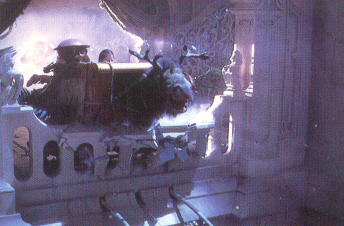
With Dorothy, Tik Tok and Billina sitting on the commandeered sofas and Jack pumpkinhead--the 'Floppy Jack' version-clinging from behind, the Gump crashes through the balcony of the tower room and sails out over the Emerald City. In reality, the breakaway set was built only a few feet off the ground and the Gump was mounted safely on rails.
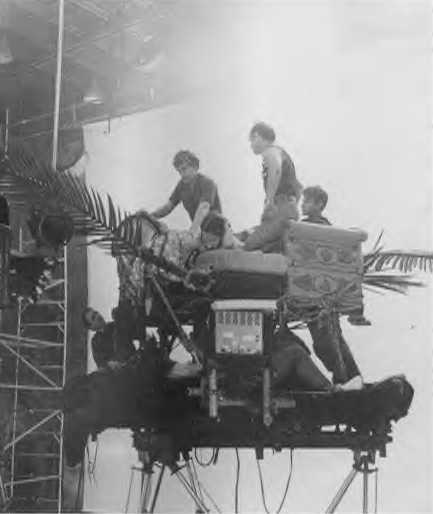
With puppeteers huddled out of camera range, the Gump is readied for one of its flying shots.
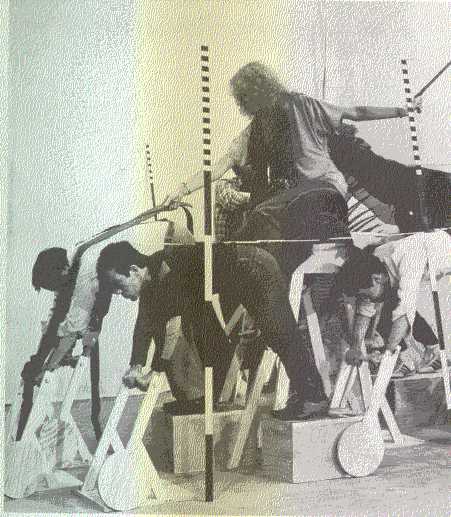
An early mockup to determine the ideal cofiguration for Mombi's Wheeler-powered sleigh.

Douglas Aberle gauges a move on the miniature Jack puppet, which is about to become a snack for the final-stage Nome King.

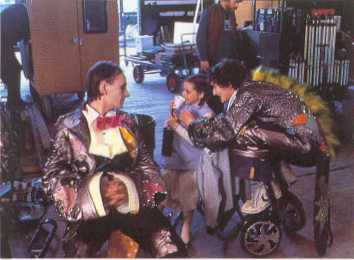
Pons Maar and Robbie Barnet share a playful moment with Fairuza Balk.
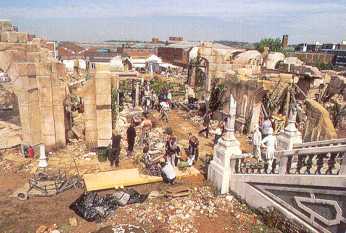
Some of the cast (mostly wheelers) and lots of the crew hanging out on break. Notice the houses in the background.
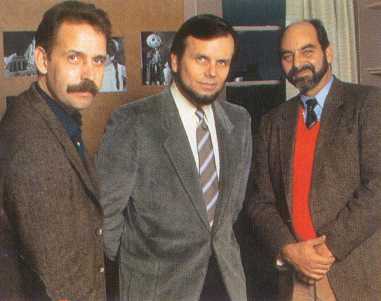
(From left to right): Walter Murch, Executive Producer Gary Kurtz, and Producer Paul Maslansky pose for the camera.

Fairuza Balk at the 1986 (for 1985 movies) Academy Awards.
Countryside on the outskirts of Chitterne doubled for Kansas, USA in the film Return to Oz, a follow-up to the Wizard of Oz, based on a story by L. Frank Baum.

A copse alongside Down Barn Road on MoD land became the setting for Dorothy's home in Kansas. Fairuza Balk, who played Dorothy and Piper Laurie, who played her Aunt Em Blue, enacted scenes around a cabin specially built amongst the trees. A crop of maize was grown nearby, on land farmed by Major Walker of Manor Farm (now Chitterne Farm West), to add authenticity.

Scenes where the actors were travelling by horse and trap were filmed near the Lodge at Tilshead and the interior shots of the cabin were filmed on sets built in the old cinema at Westdown Camp, Tilshead.
The film company made use of some locals as extras and several Chitterne children, who were attending Tilshead Primary School at the time, were amongst a group who visited the sets in Chitterne and Tilshead. Later the older children were invited to visit the film studios in London, where the main part of the film was being made, to meet ten year old Fairuza Balk. Fairuza who was with her tutor in a trailer that doubled as her classroom, explained that when she was not required on set she had to have lessons just like her visitors. The children were taken around the film lot on a small train-like vehicle to see more sets created for the film as well as others created for Star Wars. At the end of the day each child was given a photograph of Fairuza as a memento.
1. Clinic Wheeler
2. Lead Wheeler
3. Nome Messanger (voice)
4. Policeman #2 (uncredited, the one with no lines) besides being the mine movement coach. WHEW!!! :)
Thanks, Ratt(Girl) for pointing out his first role!
1. Wheeler
2.Cowardly Lion
A few pics are from the Japanese movie program (The ones in color).
One is from another site (Walter Murch with camera equipment).
Read my hand-typed transcript from the 'Fairuza Returns to Oz' Interview
